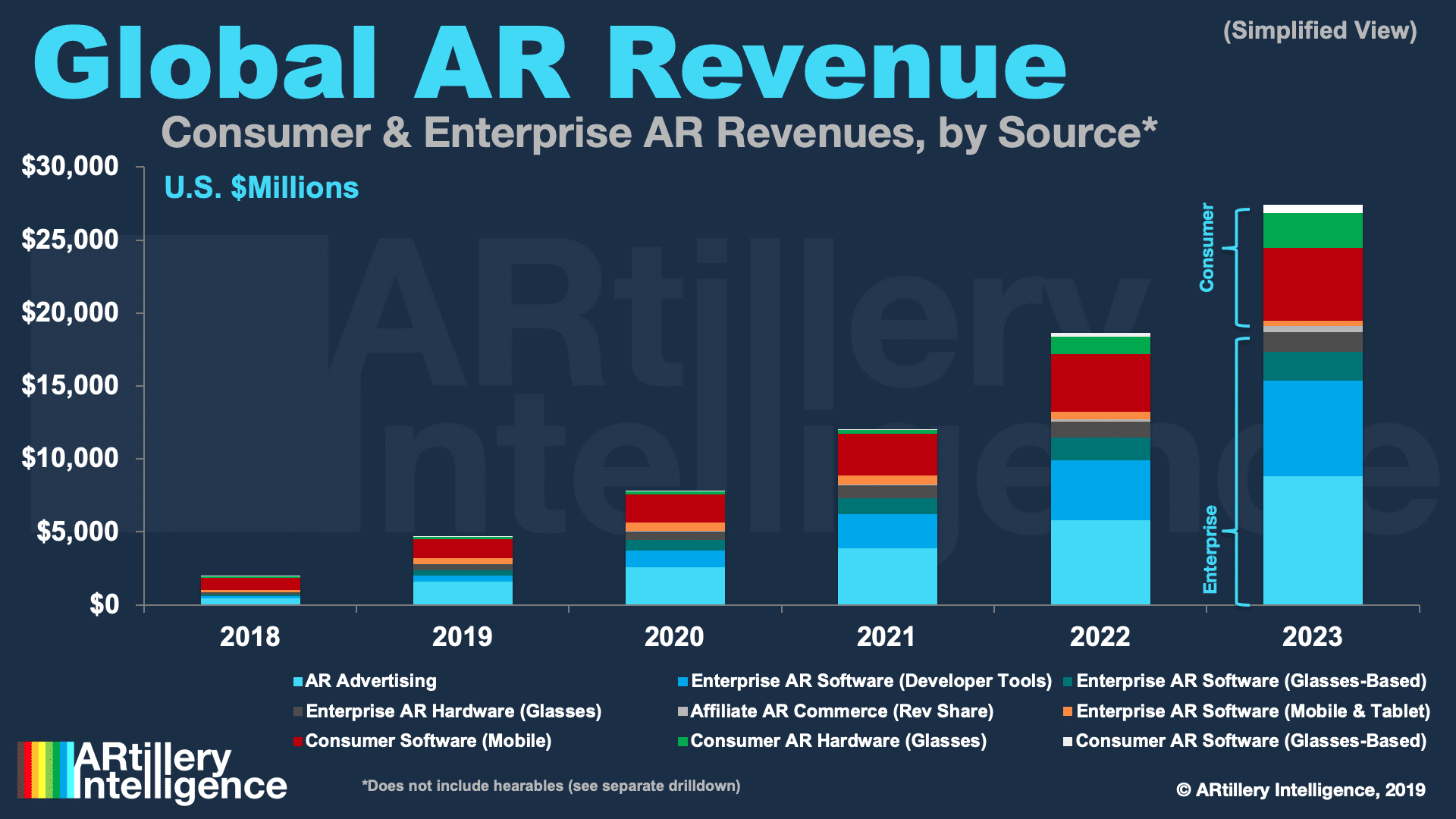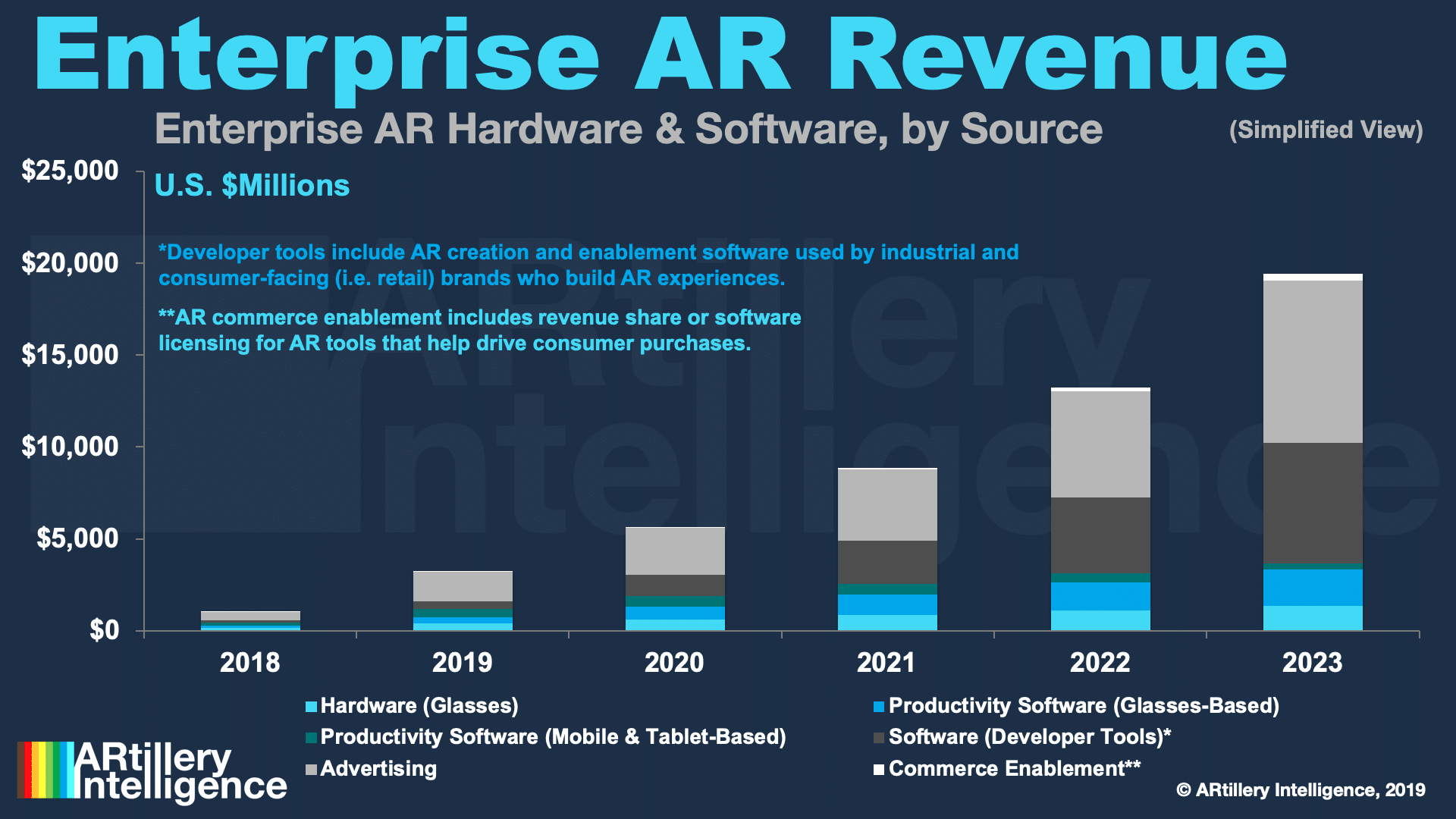
This post is adapted from ARtillery Intelligence’s report, Spatial Computing: 2019 Lessons, 2020 Outlook. It includes some of its data and takeaways. More can be previewed here and subscribe for the full report.
At this stage of spatial computing’s lifecycle, it’s becoming clear that patience is a virtue. After passing through the boom and bust cycle of 2016 and 2017, the last two years were more about measured optimism in the face of the sobering realities of industry shakeout and retraction.
As we roll into 2020, that leaves the question of where we are now? Optimism is still present but AR and VR players continue to be tested as high-flying prospects like ODG, Meta and Daqri dissolve. These events are resetting expectations on the timing and scale of revenue outcomes.
But there are also confidence signals. 2019 was more of a “table-setting” year for our spatial future and there’s momentum building. Brand spending on sponsored mobile AR lenses is a bright spot, as is Apple AR glasses rumors. And Oculus Quest is a beacon of hope on the VR side.

AR at Work
Everything examined so far in this report relates to consumer-facing AR. But what about the enterprise opportunity? Enterprise AR, particularly in industrial settings, has been positioned as AR’s saving grace while consumer adoption lingers. But it’s also seen its fair share of challenges.
Before diving in, it’s important to first define and delineate “enterprise AR.” Often, the term is used in reference to industrial uses. But “enterprise” is a much broader market segment. Think of the “enterprise software” market which addresses corporate, retail, industrial and other segments.
This is the same way we think of enterprise AR. Of course, there are use cases in industrial settings, such as automation and visualization. But there are also lots of opportunities in corporate settings (data visualization), retail (product visualization) and brand advertising.
Some of the above classifications fall into a category we’ve begun to call B2B2C. Though the end-user of a given AR experience is a consumer, it is enterprises that are adopting and deploying AR. This is usually consumer-facing companies that are using AR to engage their customers.
This category also includes developer tools such as Unity and AR democratization tools such as Amazon Sumerian or Adobe Aero. This is also known as AR-as-a-service (ARaas). Similar to SaaS in the enterprise software world, it will have a major impact on AR as we recently examined.

Heavy AR
Zeroing in on industrial AR, it continues to hold lots of promise. But like many AR sub-sectors, it’s taking longer than expected to get off the ground. This has less to do with the technology’s efficacy (which is strong) and more to do with roadblocks from human and organizational issues.
First, what are its benefits? Industrial AR’s target areas include assembly and maintenance in manufacturing. The idea is that line-of-sight visualization can guide front-line workers. Compared to the “mental mapping” they otherwise do with 2D instructions, AR support boosts productivity.
This plays out through speed, effectiveness, error reduction and safety. These micro efficiencies add up to worthwhile bottom-line impact in large-scale operations. Macro benefits meanwhile include lower strain and turnover, leading to higher morale and institutional knowledge retention.
But even though all of these advantages are well-validated, it’s challenging to get to the point of realizing them. Practical and logistical barriers stand in the way such as organizational inertia, politics, change management and fear of new technology among key stakeholders.

The 3 P’s of Industrial AR
The biggest symptom of these stumbling blocks is the dreaded “pilot purgatory.” As its name suggests, and as you may have heard in AR industry narratives, this is when AR is adopted at the pilot stage, but never progresses to full deployment. It’s the biggest pain point in industrial AR.
ARtillery Intelligence has identified sources and solution areas for these challenges, which it’s classified as the Three P’s. Comprising People, Product & Process, they’re the top areas where effective AR implementation strategies should focus in order to avoid pilot purgatory.
For people, it’s about customizing AR’s ROI story to individuals at all levels of the organization. For product, it’s all about addressing real operational pain points, uncovered through ground-level research. For process, it’s about multi-disciplinary prototyping rather than top-down innovation.
But the most important of the three is likely people (the reason it comes first). Because organizations are comprised of people, the points of adoption (and resistance) lie with people. And it’s there that AR’s value proposition should be customized and optimized for maximum results.
Stay tuned for more excerpts, ongoing commentary on the Internet of Places and check out the full report here.
For deeper XR data and intelligence, join ARtillery PRO and subscribe to the free AR Insider Weekly newsletter.
Disclosure: AR Insider has no financial stake in the companies mentioned in this post, nor received payment for its production. Disclosure and ethics policy can be seen here.
Header Image Credit: Apple
